Abstract
The replacement of luminaires with discharge lamps with high luminous efficacy and long life-time LED based equipment is a reality worldwide promoted by policies that favor their gradual substitution. There is a great concern in this manufacturing industry to develop new luminaires with low environmental impact during the manufacturing and transportation processes and its end-of-life disposal (reducing greenhouse gas emissions, toxic or hazardous components, …). Life cycle assessment (LCA) is a very extended tool used to provide information on the quality and quantity of environmental impacts in the life cycle phases of any product, system, or service. This article includes all phases of the LCA analysis of a selected streetlight LED luminaire manufactured by a SME where a landfill deposit is the end-of-life scenario. In a second phase, alternatives are sought for the reuse of the most significant elements that improve its local economy. The results are classified and sorted according to the ISO 14040 standard.
1. Introduction
Energy usage in public lighting accounts for 2.3% of the total electricity consumed in the world [1] and, according to different studies, in municipalities of developed countries, values between 40% [2] and 60% of the total municipal electricity budget can be reached [3]. A large number of public lighting installations were created 30 and 40 years ago and are therefore they can be considered obsolete [4]. Nowadays, LED technology has reached levels of energy efficiency in consolidated commercial products in the range of 70–130 lm/W [5] and the latest prototypes reach up to 200 lm/W [6] with increasingly lower costs. In addition, their lifetime expectation can be up to 5-times greater than that of discharge lamps (100,000 h LED vs. 20,000 h HPS) [7].
The construction of buildings and roads—and in particular lighting installations—are responsible for the consumption of almost half of the raw materials and energy of the planet [8]. Growing technological development causes industrial products to be discontinued and consequently replaced with greater advance [9]. Current trend of reducing greenhouse gas emissions in all fields of industry, construction, agriculture, transport, etc. Many cities replace the luminaires of public roads with others with LED technology or induction that reduce such impacts. Similar studies advise the use of indicators as efficient criteria for the selection of exterior lighting with low environmental impact [10]. For this reason, special attention should be paid to the design of new street lighting systems and to the refurbishment of existing ones, since many of them are inadequate. In light of this, it is very important to implement street lighting designs that fulfil lighting requirements, avoiding energy waste and eco-efficiency and, at the same time, result in sustainability for municipalities [11,12]. The economic and environmental impact is expected to be linked to the safety of pedestrians and drivers achieving secure levels of luminance or illuminance and keeping glare under maximum levels allowed [13]. This causes a stock of systems that are not used, which leads to its storage without knowing their end of life. However, it is very important to determine the impacts that LED luminaires will cause on the environment in the manufacturing and transportation processes. We are currently in a context in which it needs to be known if the continuous extraction of new materials has more or less environmental impacts than the recycling and reuse of the materials recovered at the end of life of the products [14].
With such an expectation, many studies are being developed that apply the life cycle assessment (LCA) methodology to analyze the environmental impacts caused in the manufacture of equipment. A product manufactured with the criteria of a low environmental impact can cause the reduction of greenhouse gases by up to 75%, the reduction of production costs by 12% and an improvement of 2–5 times in the energy efficiency of production [15]. In addition, the LCA model is currently being applied in numerous studies, such as one from Tsinghua University that aims to calculate the life cycle fossil energy consumption and greenhouse gas emissions in China [16]. These studies show that it is necessary to evaluate the environmental impact of building materials for installations using the LCA technique. Many scientific studies that use the LCA methodology compare different materials, highlighting those with a minor impact on the environment [17,18].
Comparative studies applying LCA techniques are presented as a solution between outdoor public lighting technologies [19]. In this way, similar studies have been carried out for other products, from individual products [20] to complex systems such as buildings [21]. LED lamp technology consistently improves and product development decreases the environmental impact of the manufacture of LED luminaires [22].
The present study determines, through the LCA of its components, which are the ones that cause a greater environmental impact, in order to reduce them and propose alternatives for their manufacture. The results differ between polluting elements in the environment in the categories of toxic and non-toxic. The analysis include all the life cycle scenarios of the luminaires, including the final disposal action for toxic and non-toxic wastes [23].
LCA studies allow companies to have a starting point for research and eco-design of new products, as well as the environmental improvement of those designed [24].
In a second phase, alternatives are sought to reuse most of the suitable components, which improve the local economy. The recycling of aluminum, plastic, steel, and other inorganic products is a solution to the problem of landfills. Replacing virgin plastic/aluminum with recycled plastic/aluminum results in greater environmental benefits [25].
This study investigates the environmental impacts of a road luminaire, as well as the impact caused by its recycling in another end-of-life scenarios alternative to landfill. For this purpose, we have analyzed a last generation product of an SME of this electronic devices manufacturing segment (this product is usually sold and distributed in Spain and Portugal). We have used the LCA methodology as a model to analyze the environmental impacts produced during its manufacturing and transportation process. This procedure can be used by similar distributors and marketers to incorporate it into the ecological label of their products.
2. Methodology
LCA is a general methodology useful to evaluate the impact of any design of products, process, and services on human health and the ecosystem [26,27].
According with their description in Table 1 [28,29,30,31] LCA is defined as the collection and evaluation of the inputs and outputs to determine any possible environmental impacts of the element evaluated during its life cycle. Thus, this is a tool for the analysis of the environmental burden of products in all its phases from the extraction of resources, production of components and the product itself, distribution and use of the mentioned product, and its residue management after being discarded, whether re-purposing, recycling, or final disposal [30,31].

Table 1.
List of ISO standards with their content description related to define the LCA analysis.
The procedure detailed to perform a LCA analysis is composed of four phases: (1) goal and scope definition, (2) life cycle inventory analysis, (3) life cycle impact assessment, and (4) interpretation of results.
According to the previous approach, the first objective of this work was to determine the impacts of street light systems using the LCA through the EPS 2000 (Environmental Priority Strategies in product design) [32] and the CML-IA baseline [33] methods. This would provide us with information concerning the quantity and importance of CO2 emissions to the atmosphere of the studied system as well as other important impacts. From the analysis of the results, we can determine the environmental impacts that were found during the manufacture and operation of the equipment. The information which LCA provides us, and to determine in investment policies and reduce the impacts on the environment, and what materials have recycling potential to incorporate them into a new end-of-life cycle as components of other raw materials [24].
To perform the LCA we have chosen a model LED streetlight luminaire, assembled in Spain and commercially distributed, mainly, in the Iberian Peninsula and countries in the north shore of Africa (Morocco and Argelia). This luminaire integrates LED devices and electronic and electric elements manufactured or assembled in the USA and, mostly, in China, like most of the products of this class in the current market in the EU countries and that are being used massively to undertake substitutions in exterior lighting renovations.
2.1. Equipment
For the introduction of the data in the calculation software SimaPro 8.3, it is necessary to have an absolute knowledge of the product considering all its components (materials, weights, origin, manufacturing processes, consumptions, etc.) as well as their functions [1].
Functional unit: LED Luminaire. Family: ViaSolP, assembled and distributed from Málaga (Spain) by the company SOLITEC [34] Model: ViaSolP-50-N, nominal power: 50 W—correlated color temperature (CCT): 4,000 K—Surge Voltage Protector (SVP): 20 kV/10 kA—Class I). Architecture: aluminum heatsink housing, tempered glass screen, LED optical block with electronic control integrated and set of an electric driver unit and protections. The arm segment with which the luminaire is attached to the poles is not considered a part of the streetlight in this study [14,35].
We can break down this LED luminaire fixture in an architecture consisting of three basic components: a luminaire body or heatsink housing with a transparent light output window, a driver or AC/DC-CC power supply accompanied by electric protection and connection elements and light source or optical block that includes an electronic control system. This last block consists of a printed circuit board (PCB) where the LED matrix and all the integrated circuits required and placed along with polymethyl methacrylate (PMMA) lenses that generates the specific photometric diagram of the light emitted. The configuration of the LEDs matrix to generate the luminaires is carried out based on a scalable structure. This allow achieving different power setups considering a different number of emitters. The modules mounted each with a variable number of LED diodes form the light matrix of the lamp [36,37,38].
As presented in Figure 1, the streetlight body measures 112 (height) × 495 (length) × 227 (width) mm. Within the luminaire body a 1.6 mm thick aluminum PCB (an insulated metal substrate based aluminum clad with copper foil on the opposite side) with lines and pads to solder up to 24 LEDs (3 × 8 parallel/serial matrix configuration) is incorporated. The possible options that can be selected to configure a luminaire from two different modular blocks each mounted with a variable number of diodes formed the luminous matrix of the luminaire. Other minor components of the luminaire, such as screws, cables, and small electrical complements (wire crimp connectors and holders, etc.), have not been incorporated into the study since it is estimated that their weight in the set is not significant and/or they are not manufactured with materials that produce impacts on the environment [39]. The data used in the information gathering phase for the LCA is provided in detail by the manufacturer and verified or supported by the documentation existing in the bibliography on the product [40,41]. Table 2 shows the technical specifications of the LED luminaire chosen [28].
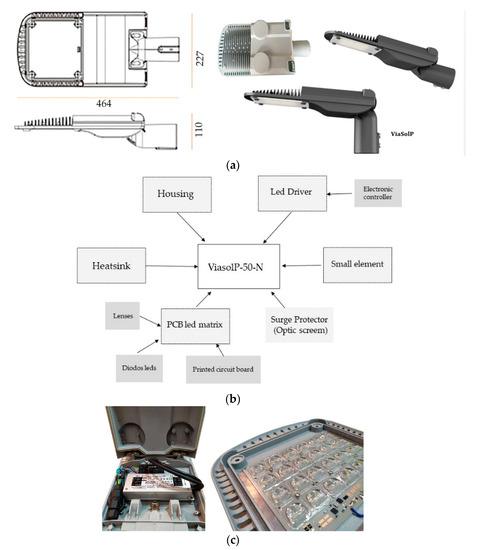
Figure 1.
LED Streetlight luminaire, Family: ViaSolP. (a) General view and dimensions. (b) Outside diagram. With different parts of luminaries. (c) Image of PCB with electric elements (LED-Driver) and a LED-matrix with image of lenses (Source: SOLITEC).

Table 2.
Detailed technical specifications of the LED luminaire evaluated (Source: SOLITEC)
Throughout the life cycle, the distances necessary for the extraction, processing and manufacturing of the materials necessary to obtain the luminaire have been calculated. This phase of LCA involves quantifying the inputs and outputs of the activities of the system evaluated. Four steps are performed in life cycle inventory (LCI): (1) develop a flow diagram of the process, product, or service evaluated, (2) develop a data collection plan, (3) collect data, and (4) evaluate and report LCI results. (Figure 2)
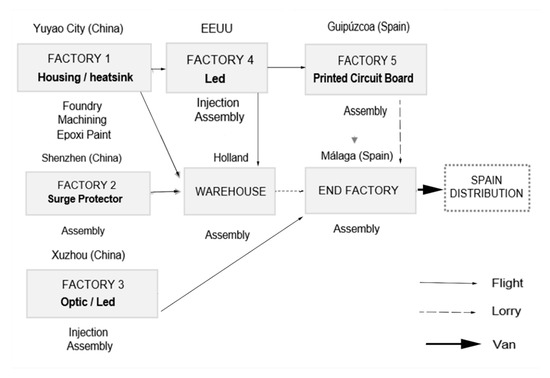
Figure 2.
Simplified components and manufacturing transport diagram of the LED luminaire (Source: SOLITEC).
Figure 3 shows the diagram with the life cycle considering all the processes, which include in the final packaging, the distribution toward the end user, its usage and the final disposal in landfill/warehouse.
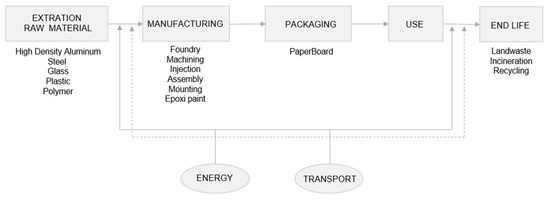
Figure 3.
Simplified scheme of the life cycle diagram of the luminaire from cradle to grave (Source: self-made).
LED encapsulated include a series of metals that although in small quantities are quite valuable. The most significant are “gallium (Ga) and indium (In), rare earth elements like yttrium (Y) and cerium (Ce), and precious metals such as gold (Au) and silver (Ag)” [41]. These metals have not result significant in the LCA analysis as:
- Their quantity is very small with respect to the total system studied. “It is a considerable challenge the full recycling of LED devices The difficulty concerns the methods used to sort and reuse these materials, especially due to the small amounts used” [42]. However, “To compensate for the gap between the growing demands and restricted supply of these metals, many countries have given significant focus on obtaining them through the E-waste” [43].
- This material are not included in the list of material considered as dangerous by the UE Directives (RoHS [44] & WEEE [45]) and Regulations [46,47], as declared by the certificates of the LED models included in the luminaire and available in the web page of the manufacturer. Thus, they do not entail considerable environmental impacts.
Toxic heavy metals (such as As, Fe, Cu, etc.) that may threaten the environment (soil and underground water pollution) or the health of humans/animals, reported in some works [48,49,50,51,52], are not found in the LED model used.
2.2. Annual Energy Consumption
The calculation of the annual energy consumption of the LED Luminaire has been done within the following limits: 11 annual medium daily working hours with a service life of 20 years (80,000 h). These values are estimated considering the lifetime expectation of the different components of the luminaire where the two limiting elements are the LEDs (estimated using the IES LM-80-2015: LM-80 test and TM-21 report) and the LED driver (estimated using the MIL-HDBK-217F Notice 2 Stress analysis test).
The functional unit of the LCA can be determined based on the quantity and quality of the light depending on a period of use of the same. This is important in the case of performing comparative LCAs between different luminaires, since it can significantly affect the results, especially if variable criteria are used for each luminaire [49]. In our case, we use the useful life to facilitate data collection in the inventory, as explained in the previous paragraph.
The inventory of entrances and exits during the extraction of the materials was adapted to the procedures defined in the ecoinvent database [45]. This was prepared under a cooperation agreement between the Swiss Federal Institute of Technology Zurich (ETH Zurich), the Paul Scherrer Institute (PSI), the Swiss Federal Laboratories for Materials Testing and Research (EMPA), and the Swiss Federal Agroscope Research Station (ART). It contains more than 2.5 million data sets for products and services in the energy, agriculture, transportation, construction materials, chemicals, pulp and paper, waste treatment, and agricultural sectors for different continents [34,50,51].
This tool allows us, once the data has been entered, to obtain the environmental pollution units through various impact categories. These are calculated according to the calculation method selected [52].
The distribution for the use of the luminaires has been carried out in the Iberian Peninsula (Portugal and Spain), calculating the values of km of transport through commercial vehicles. Once the luminaire’s useful life has been completed, an end-of-life scenario of storage in warehouse/re-incorporation of recyclable material as raw material is contemplated. The environmental behavior of material collection and energy consumption in the reincorporation of the material into the productive cycle (circular economy) is studied. Table 3 shows the Life Cycle Inventory (LCI) of materials, energy, transport and waste of the LED luminaire under study.

Table 3.
LCI of materials of the LED Luminaire ViaSolP-50-N
To establish the environmental impact of the luminaire, three different aspects have been considered: the analysis of the inventory, the evaluation of the impact and the interpretation of the analysis.
The SimaPro v8.30 software [53,54,55,56,57] supported by two calculation methods it is used to conduct a sensitivity study that indicates a possible deviation from the results obtained [52]. The EPS 2000 [32] and the CML-IA baseline [54] methods are the best options to calculate the environmental impacts associated with the life phases described as both methods give us a similar level of aggregation of results [49,52]. The EPS 2000 is an evaluation system based on scientific and pragmatic knowledge for eco-design and is focused in the evaluation of the final damage, using a two-level weighting system. The first one within each protection area (resources, ecosystem and human health) and the second one on the panel type. The ultimate goal is to obtain the total environmental burden of a product or system through a single unified score. The CML-IA baseline is a LCA methodology developed by the Center of Environmental Science (CML) of Leiden University in the Netherlands. This method elaborates the problem-oriented midpoint approach and provides a list of impact assessment of obligatory impact categories that are among the most used in LCAs. The baseline indicators are recommended for simplified studies [33,55].
The selection of the analysis methods is clearly linked to our objective, because we seek to determine which components of the luminaire studied are the ones that have the greatest impact, in the first place and which ones can be recovered for reuse as raw material. These data provide us with information to achieve eco-design development in this type of products [54,56].
The EPS 2000 method assesses four main impact categories and which correspond to: the loss of ecosystem regeneration (PDF·m2·yr) the damage caused to people’s health (DALY), depletion of natural resources (MJ/Kg), and the depletion of biodiversity (PDF·m2·yr) [32]. This method represents the environmental effects of the evaluated system model using 13 midpoint indicators and has priority environmental strategies for the design of products and the latest version of the EPS method evaluates the impact on the environment through its effects in one or several human health themes (Table 4).

Table 4.
Environmental aspects evaluated by the EPS 2000 method with their reference units
CML-IA baseline method assesses five main impact categories. This CML method represents the environmental effects of the evaluated system model using 11 midpoint indicators (e.g., global warming, ozone depletion, water acidification, creation of photochemical oxidant, and water eutrophication), which determinate the five endpoint indicator values [58,59,60,61,62]. This method offers us information on environmental impacts such as shown in Table 5.

Table 5.
Environmental aspects evaluated by the CML-IA baseline method with their reference units
3. Results
The aim of this section is to determine all the possible environmental impacts related to the parameters obtained in the previous section. The present study will be carried out in accordance with priority strategies of the EPS 2000 method, and to the following sequence of tasks: classification, characterization (indicators are selected according to each category of impact), standardization, and valuation.
The categories of impact are identified from the following issues: production capacity of the ecosystem (including information relating to agriculture, fish or meat, and the decrease in timber field), protection of human health (including human diseases), natural resources and abiotic resource in stock, with the environmental cost, resources, and biodiversity (including the extinction of species) [59,60].
The EPS 2000 method assesses. In order to perform a correct analysis of the results, the software allows simplifications and groupings of the results based on the characteristics of the impacts, grouping according to the categories of the selected method.
As it can be seen in Figure 4, the greatest impacts occur on the depletion of resources, based on the consumption of fossil fuels due to the excessive transport of the different components of luminaires. With a smaller percentage, but not negligible, we see that the impacts on human health must also be reduced and the possible alternatives analyzed. With less importance, we find the impacts to the capacity of regeneration of the ecosystem and the reduction of biodiversity.
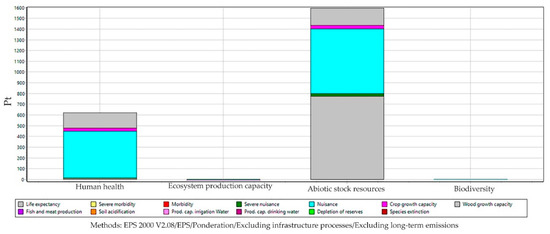
Figure 4.
Weighting phase for LCA evaluation with the EPS 2000 method. Simplification to assign relative importance weights to each of the impacts founds (Pt: point of impact) (Source: self-made).
Through the single score we can determine the kPt value for the LED street lighting equipment, in factory processes where the greatest impact is found [32]. The transport by plane to the assembly plant in Spain is the one that has the greatest impact, being up to 72% greater than with respect to the rest of means. In addition, road transport is added by truck or van for last mille and end-product distribution. This fundamentally affects human health. On the other hand, the manufacture of the housing (heatsink) in the factory, generates an important impact on the reduction of abiotic resources. The rest of the impact are of little relevance. Figure 5 illustrates more in detail the information on those impact categories that are most affected. Adding the impacts produced both in the manufacturing processes and in the transport of the housing and the other hand, power supply, it results in 87% of impacts on the reduction of reserves, and 13% on the life expectancy. In this study, the packaging has a lower relative impact than other processes.
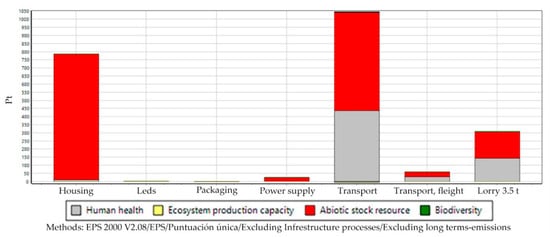
Figure 5.
Single Score phase for LCA evaluation with the EPS 2000 method. Simplification to assign relative importance weights to each of the impacts founds (Pt: point of impact) (Source: self-made).
Figure 6 shows the single score obtained per category with this method. In this stage, the relative importance of each category of impact is determinate. The eco-point indicator (kPt) is used [61]. It must be considered that the absolute value of the points is quite irrelevant, as the main aim is to compare relative differences between the products or components.
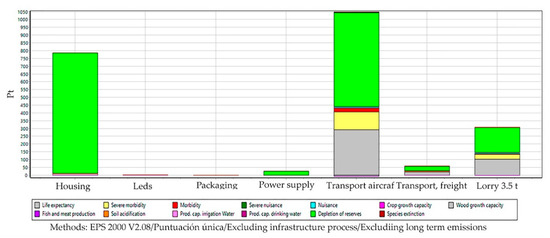
Figure 6.
Single score phase classified by categories for LCA evaluation with the EPS 2000 method.
The weighed factors to the energetic consumption and the categories are shown in Table 6. The values for the single score method and the products that produce these impacts.

Table 6.
Affected categories and weighed factors related to the resource consumption. LCA + EPS 2000 method (Source: self-made).
As common point to the results obtained, we can determine that energetic consumption in the form of electricity is the most relevant factor for the LCA analysis.
To simplify results, contributions to environmental impact indicators, the values have been sorted into four groups. The performed analysis included the different stages of life of each one of the constituents, but it must be borne in mind that the variation of conditions of their use as well as the length of operational lifetime may change the results.
With the scenario of 100% virgin raw material formulation [62], results are obtained that indicate that the greatest environmental effects were achieved in the categories corresponding to the extraction of materials (57%), the generation of inorganic material in suspension within of the atmosphere added to human health (41%), the ecosystems quality (1%), and biodiversity (1%). Such impacts occurred in the stages of extraction, transformation, and transport of materials (see Figure 7).
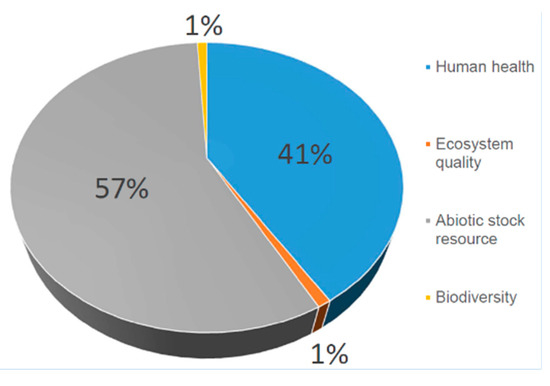
Figure 7.
Relative importance of impacts according four categories. % Impacts. Method EPS 2000.
Breaking down the results, we can say that in the extraction of materials, the largest contribution corresponded to aluminum (75.2%), steel (12.3%), plastic (7.0%), and glass (5.5%). Volatil inorganic material, it was determined that the main components are NOx and SOx emissions.
In the other hand, the CML-IA baseline method indicates that the consumption of fossil resources are the 96.9% for the housing and a 23% for the LEDs encapsulated, and are the main impact factor, which is increased to 91.3% that we can see in the characterization of flight transport. With the consumption of mineral fuel, respiratory effects caused by inorganic substances air emissions such as SOx and NOx (human toxicity) together with climatic change due to CO2 emissions (global warming).
The quality of ecosystems is mainly affected by marine aquatic (38.5%), acidification and eutrophication (71.8%), and ozone layer (75.8%). Damages caused by eco-toxicity are chiefly because of heavy metals emissions in air and water, while the damages by acidification and eutrophication are principally owing to NOx and SOx emissions. The driver or power supply only affect to abiotic depletion. Figure 8 shows the values for the method, as well as the products they produce these impacts. This graph shows that human toxicity is the most important related to life expectancy.
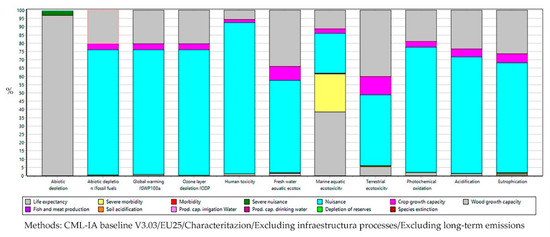
Figure 8.
Characterization phase for the LCA analysis simplified to assign the relevance of each of the impacts trough relative weights using the CML-IA baseline method.
Figure 9 shows the same results as Figure 8, but with uPt score values that the standard does not consider mandatory in LCA studies, but allow a better interpretation of the results.
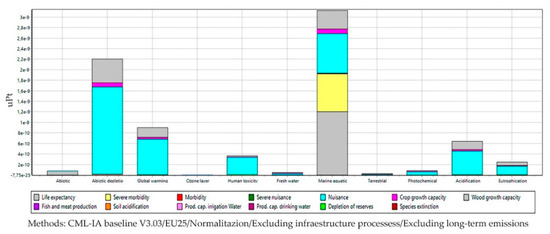
Figure 9.
Normalization phase classified by categories for better understanding categories. CML-IA baseline. Eco-point indicator (uPt) is used.
As before, we can determine that energetic consumption in form of electricity is the most relevant factors for the LCA. Table 7 shows the most affected categories and the largest weighed factors related to energy consumption according to the CML-IA baseline method.

Table 7.
Most affected categories and weighed factors related to energy consumption. Analysis: CML-IA baseline method (source: self-made).
To simplify results, contributions to environmental impact indicators, the values have been sorted into four groups. The performed analysis included the different stages of life of each one of the constituents, but it must be borne in mind that the variation of conditions of their use as well as the length of operational lifetime may change the results.
Figure 10 shows results consistent with those obtained in Figure 7. Showing percentages corresponding to the extraction of materials with (46%), the generation of inorganic matter added to human health (36%), the quality of ecosystems similar to marine aquatic ecotoxicity (7%), and abiotic depletion (11%).
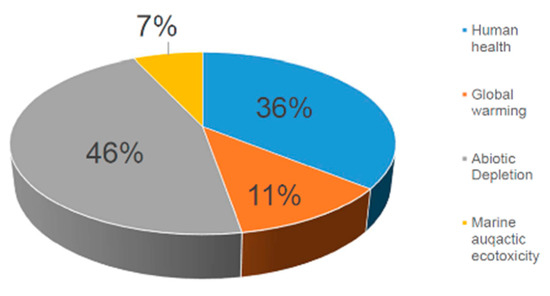
Figure 10.
Relative importance of impacts according to four main categories. % Impacts. LCA + CML-IA baseline method.
Performing an analysis of the results obtained, it is observed that the greatest impacts occur in the depletion of resources. These results coincide in the methods used, so as an analysis of these results it leads us to justify the need to reduce the extraction of raw materials.
4. Discussions
The results obtained are consistent with respect to those presented in similar works applied to similar products and counting only direct contributions [60]. Analyzing the results obtained, we can summarize the discussion in the following fundamental points.
The national or even the local production of some elements and/or systems is scarce, reducing in some cases to the mere assembly of elements. It is necessary to incorporate eco-design both to reduce the amount of material used and to achieve a greater location of the components that avoid the important impacts of transport. Eco-design is an environmental benefit that has an economic benefit since most of the improvements refer to the decrease in material [10,57,63]. It is important to consider that the results of the analyzes may be affected by the place where the study is carried out, which mainly affects the impacts caused by the greater or lesser transport of the components in the manufacturing phase. The LCA studies considering would provide designers with important data for their decision-making in different manufacturing scenarios.
The components of the luminaires have different manufacturing areas, some far away, which causes a considerable increase in the impacts of transport to the final assembly site. The end of life of components such as the housing does not present alternatives to landfill or incineration, due to the material with which it is manufactured.
It is necessary the environmental analysis of the alternative of recycling and incorporation to other materials, as an alternative of reuse of the plastic or aluminum on the housing heatsink [62].
When not finding LCA studies on similar luminaires, it is necessary to carry out other comparative LCA studies, with LED luminaires of the latest technology, and under local production that provides us with environmental information on these products and that can be used for decision making along with other aspects such as economic, technical, maintenance, etc. [64].
Depending on the limits that we have established in the present study, the LEDs include in their manufacturing processes a series of metals that although in small quantities are quite valuable. The most significant are the Ga, In and the rare earths. A point to consider within the circular economy would be the recovery of these metals, through green and clean technologies, based on end-of-life techniques of the LEDs components, as well as recent studies support [41,43,48].
5. Conclusions
It is important to consider the end of life of all the components of the LED luminaires due to the increasing scarcity of resources and the exclusively environmental consequences that the processing entails. Based on the data obtained from LCAs, a path is opened to determine which recycling and reuse processes are the most suitable depending on the individual variables of each system studied. In the same way, the manufacturing companies must incorporate self-recycling environmental policies that provide direct raw materials and complement their manufacturing processes, thus reducing environmental impacts considerably.
In future studies, new technologies should be considered that allow us to analyze recycling scenarios in which the components of LED luminaires are included as the basis for a local circular economy. This provides a significant reduction in the overall impacts of the product, in terms of the uPt indicator. In the design phase of the luminaires, where the materials, the composition of the recycled material, and other relevant considerations are selected, these aspects affect the processes to be used, the quality of the product and its relationship with the environment. The most important point is to reduce the cost transport of the components and for this reason it is necessary to conduct LCA studies with different scenarios in which the differences in the results are collected by varying the countries of extraction of raw materials, processing, and use of the luminaires, all affected by the mix of electrical energy of each country in each case. LCA methods with two methodologies has been used in the present work to determine the LED luminaires impacts like study case. The most localized manufacturing would bring economic and social improvement to local scale. The lower potentials of the LEDs are mainly due to the longer useful lifespan. An LCA study, however, has shown that, relative to incandescent bulbs, LEDs represent approximately an 80% reduction in primary energy demand and in global warming, human toxicity, and resource depletion potentials during the use and manufacturing stages [65,66].
On the other hand, research into new materials manufacturing technologies, less polluting, would favor this location, reducing transport cost, and let changing oriented to local manufactured production with recycled materials (circular economy). LCA of the luminaires, let evaluate the use of by-products or waste and their recycled incorporation into the industrial life cycle [61,67]. Consequently, the products with the lowest impact will allow a reduction in CO2 and CH4 emissions, as well as a reduction in the consumption of energy and resources.
In this way, the use of low-cost recycled materials with a low environmental impact, which are also close to the production centers, and their return to manufacturing processes through recovery, would be encouraged by the public administrations, allowing the promotion of circular economic strategies.
The waste generated by the replacement of the luminaires with others that incorporate new technologies, are very abundant and represent up to 72% of the total volume. These elements must be reincorporated into the manufacturing life cycle of the same luminaires or other life cycles that may be complementary due to their characteristics and affinities. The use of recyclable or bioplastic plastics can be a solution that allows its recovery as waste and its subsequent use for the manufacture of biogas or in the manufacture of construction materials for sustainable buildings. In this regard, it is noteworthy that tests are already being carried out regarding the use of electrical plastic waste to produce syngas or gasification gas [68,69] or as a material for sustainable construction [18].
On the other hand, aluminum is a highly appreciated metal that could be used as a material for the manufacture of anodes or cathodes in hydrolysis processes to obtain hydrogen, as a possible future use. It is possible to reuse the metal base, which is of great value mainly as aluminum for industrial reuse, as an electrical conductor, or as electrodes in the hydrolysis processes for the production of H2 [70].
Author Contributions
The author contribution is summarized: Conceptualization: M.J.H.-O. and J.A.L.-M.; Methodology: M.J.H.-O. and J.A.L.-M.; Software: J.A.L.-M.; Validation: A.G.-C. and M.J.H.-O.; Formal analysis: A.G.-C. and M.J.H.-O.; Investigation: M.J.H.-O. and J.A.L.-M.; Resources: M.J.H.-O. and P.B.; Data curation: M.J.H.-O.; Writing: M.J.H.-O.; Writing—review and editing A.G.-C.; Supervision and funding acquisition, P.B. All authors have read and agreed to the published version of the manuscript.
Funding
This research did not receive external financing directly; However, in this work, Hermoso-Orzáez Manuel Jesús has participated as a principal investigator in the research carried out at the Center Polytechnic Institute of Portalegre (Portugal), participating as a Scholarship Scholar with the “José Castillejo” Grant of the Ministry of Education and Science of the Government of Spain, within the international project-project of cross-border cooperation ECO2CIR for the introduction of ecology. and circular economy through the prevention of improved recycling, waste management and recovery in the central, Extremadura and Alentejo regions. (Interreg Spain-Portugal) supervised by Brito Paulo, with the aim of looking for Models that serve as a reference for massive LED replacements that are expected to be carried out in the short and medium term, for additional waste treatment and recovery in the regions of Alentejo (Portugal) and Extremadura (Spain).
Acknowledgments
We thank to the manufacturer of the luminaire SOLITEC for providing us with all the information necessary to perform the LCA analysis developed.
Conflicts of Interest
The authors declare no conflict of interest.
References
- Lobão, J.A.; Devezas, T.; Catalão, J.P.S. Energy efficiency of lighting installations: Software application and experimental validation. Energy Rep. 2015, 1, 110–115. [Google Scholar] [CrossRef]
- Ozadowicz, A.; Grela, J. The street lighting integrated system case study, control scenarios, energy efficiency. In Proceedings of the 19th IEEE International Conference on Emerging Technologies and Factory Automation, ETFA 2014, Barcelona, Spain, 16–19 September 2014. [Google Scholar]
- Fiaschi, D.; Bandinelli, R.; Conti, S. A case study for energy issues of public buildings and utilities in a small municipality: Investigation of possible improvements and integration with renewables. Appl. Energy 2012, 97, 101–114. [Google Scholar] [CrossRef]
- Traverso, M.; Donatello, S.; Moons, H.; QuinteroR, R.; Gama Caldas, M.; Wolf, O. Revision of the EU green public procurement criteria for street lighting and traffic signals—Preliminary report. EJRR 2018, 9, 316–328. [Google Scholar]
- Djuretic, A.; Kostic, M. Actual energy savings when replacing high-pressure sodium with LED luminaires in street lighting. Energy 2018, 157, 367–378. [Google Scholar] [CrossRef]
- Miller, N.J.; Beeson, T.; Mcintosh, J.; Safranek, S. Top Efficacy Performers: An Investigation into High-Achieving Led Luminaires; Pacific Northwest National Laboratory: Richland, WA, USA, 2018.
- Shahzad, K.; Čuček, L.; Sagir, M.; Ali, N.; Rashid, M.I.; Nazir, R.; Nizami, A.S.; Al-Turaif, H.A.; Ismail, I.M.I. An ecological feasibility study for developing sustainable street lighting system. J. Clean. Prod. 2018, 175, 683–695. [Google Scholar] [CrossRef]
- Edwards, B. Rough Guide to Sustainability: A Design Primer, 4th ed.; RIBA Publishing: London, UK, 2014; ISBN 9781859465073. [Google Scholar]
- Hermoso-Orzáez, M.J.; Rojas-Sola, J.I.; Gago-Calderón, A. Electrical consequences of large-scale replacement of metal halide by LED luminaires. Light. Res. Technol. 2018, 50, 282–293. [Google Scholar] [CrossRef]
- Leccese, F.; Salvadori, G.; Rocca, M. Critical analysis of the energy performance indicators for road lighting systems in historical towns of central Italy. Energy 2017, 138, 616–628. [Google Scholar] [CrossRef]
- Beccali, M.; Bonomolo, M.; Leccese, F.; Lista, D.; Salvadori, G. On the impact of safety requirements, energy prices and investment costs in street lighting refurbishment design. Energy 2018, 165, 739–759. [Google Scholar] [CrossRef]
- Hermoso-Orzáez, M.J.; Lozano-Miralles, J.A.; Lopez-Garcia, R.; Brito, P. Environmental Criteria for Assessing the Competitiveness of Public Tenders with the Replacement of Large-Scale LEDs in the Outdoor Lighting of Cities as a Key Element for Sustainable Development: Case Study Applied with PROMETHEE Methodology. Sustainability 2019, 11, 5982. [Google Scholar] [CrossRef]
- Peña-García, A.; Hurtado, A.; Aguilar-Luzón, M.C. Impact of public lighting on pedestrians’ perception of safety and well-being. Saf. Sci. 2015, 78, 142–148. [Google Scholar] [CrossRef]
- Douglas, H.; Jurgens, C.; Zatcoff, E. Life Cycle Assessment of Streetlight Technologies; University of Pittsburgh, Mascaro Center for Sustainable Innovation: Pittsburgh, PA, USA, 2009. [Google Scholar]
- Moon, D.; Sagisaka, M.; Tahara, K.; Tsukahara, K. Progress towards sustainable production: Environmental, economic, and social assessments of the cellulose nanofiber production process. Sustainability 2017, 9, 2368. [Google Scholar] [CrossRef]
- Peng, T.; Zhou, S.; Yuan, Z.; Ou, X. Life cycle greenhouse gas analysis of multiple vehicle fuel pathways in China. Sustainability 2017, 9, 2183. [Google Scholar] [CrossRef]
- Monteiro, H.; Freire, F. Life-cycle assessment of a house with alternative exterior walls: Comparison of three impact assessment methods. Energy Build. 2012, 47, 572–583. [Google Scholar] [CrossRef]
- Pargana, N.; Pinheiro, M.D.; Silvestre, J.D.; De Brito, J. Comparative environmental life cycle assessment of thermal insulation materials of buildings. Energy Build. 2014, 82, 466–481. [Google Scholar] [CrossRef]
- Tähkämö, L.; Räsänen, R.S.; Halonen, L. Life cycle cost comparison of high-pressure sodium and light-emitting diode luminaires in street lighting. Int. J. Life Cycle Assess. 2016, 21, 137–145. [Google Scholar] [CrossRef]
- Bonamente, E.; Scrucca, F.; Rinaldi, S.; Merico, M.C.; Asdrubali, F.; Lamastra, L. Environmental impact of an Italian wine bottle: Carbon and water footprint assessment. Sci. Total Environ. 2016, 560–561, 274–283. [Google Scholar] [CrossRef]
- Fantozzi, F.; Gargari, C.; Rovai, M.; Salvadori, G. Energy upgrading of residential building stock: Use of life cycle cost analysis to assess interventions on social housing in Italy. Sustainability 2019, 11, 1452. [Google Scholar] [CrossRef]
- Richter, J.L.; Tähkämö, L.; Dalhammar, C. Trade-offs with longer lifetimes? The case of LED lamps considering product development and energy contexts. J. Clean. Prod. 2019, 226, 195–209. [Google Scholar] [CrossRef]
- Butera, S.; Christensen, T.H.; Astrup, T.F. Life cycle assessment of construction and demolition waste management. Waste Manag. 2015, 44, 196–205. [Google Scholar] [CrossRef]
- Lozano-Miralles, J.A.; Hermoso-Orzáez, M.J.; Martínez-García, C.; Rojas-Sola, J.I. Comparative study on the environmental impact of traditional clay bricks mixed with organic waste using life cycle analysis. Sustainability 2018, 10, 2917. [Google Scholar] [CrossRef]
- Bogner, J.; Pipatti, R.; Hashimoto, S.; Diaz, C.; Mareckova, K.; Diaz, L.; Kjeldsen, P.; Monni, S.; Faaij, A. Mitigation of global greenhouse gas emissions from waste: Conclusions and strategies from the Intergovernmental Panel on Climate Change (IPCC) Fourth Assessment Report. Working Group III (Mitigation). Waste Manag. Res. 2008, 26, 11–32. [Google Scholar] [CrossRef] [PubMed]
- Rebitzer, G.; Ekvall, T.; Frischknecht, R.; Hunkeler, D.; Norris, G.; Rydberg, T.; Suh, S.; Weidema, B.P.; Pennington, D. Life cycle assessment Part 1: Framework, goal and scope definition, inventory analysis, and applications. Environ. Int. 2004, 30, 701–720. [Google Scholar] [CrossRef] [PubMed]
- Curran, M.A. Learn more about Life Cycle Assessment Life Cycle. Encycl. Ecol. 2008, 4, 2168–2174. [Google Scholar] [CrossRef]
- ISO 14040:2006. ISO 14040:2006 Environmental Management—Life Cycle Assessment—Principles and Framework; BSI: London, UK, 2006. [Google Scholar]
- ISO. ISO/TR 14047:2012 Environmental Management—Life Cycle Assessment—Illustrative Examples on How to Apply ISO 14044 to Impact Assessment Situations; ISO: Geneve, Switzerland, 2012; p. 85. [Google Scholar]
- Navajas, A.; Uriarte, L.; Gandía, L.M. Application of eco-design and life cycle assessment standards for environmental impact reduction of an industrial product. Sustainability 2017, 9, 1724. [Google Scholar] [CrossRef]
- European Commission on Resource Efficient Opportunities in the Building Sector. Communication from the Commission to the European Parliament, the Council, the European Economic and Social Committee and the Committee of the Regions COM(2014); EU: Brussels, Belgium, 2014; pp. 1–10. [Google Scholar]
- Steen, B.; Arvidsson, P.; Nobel Gunnar Borg, A.; Louis, S.; Thomas Rydberg, V.; Göran Swan, V.; Enso David Weiner, S. A Systematic Approach to Environmental Priority Strategies in Product Development (EPS). Version 2000—General System Characteristics; Chalmers Tekniska Högsk: Gothenburg, Sweden, 1999; p. 67. [Google Scholar]
- CML—Department of Industrial Ecology CML-IA Characterisation Factors. Available online: https://www.universiteitleiden.nl/en/research/research-output/science/cml-ia-characterisation-factors (accessed on 5 September 2016).
- Solitec-Viasolp. Technical Catalog on Led Lighting. Outdoor Street Lights. Available online: http://www.solitecled.com (accessed on 10 January 2018).
- Azevedo, I.L.; Morgan, M.G.; Morgan, F. The Transition to Solid-State Lighting. Proc. IEEE 2009, 97, 481–510. [Google Scholar] [CrossRef]
- CIE Spanish Lighting Committee. Required Technical Requirements for Luminaires with Led Outdoor Lighting Technology; CIE: Madrid, Spain, 2015. [Google Scholar]
- CIE Spanish Lighting Committee Mixed Supply and Services Contract for the Provision of the Integral Outdoor Lighting Service of the Municipality of (AYTO) Specification sheet IDAE Contract Models. Available online: https://www.ceisp.com/el-cei/biblioteca/documentacion-eses/ (accessed on 5 December 2016).
- Zhang, H.; Burr, J.; Zhao, F. A comparative life cycle assessment (LCA) of lighting technologies for greenhouse crop production. J. Clean. Prod. 2017, 140, 705–713. [Google Scholar] [CrossRef]
- Minguez, R.; Zamora, S.; Barrenetxea, L.; Solaberrieta, E.; Etxaniz, O.; Muniozguren, J.; Izcaro, J.; Larrieta, J.; Lopez, J. Life Cycle Assessment in Switchgears for Primary Electrical Distribution. DYNA 2013, 88, 543–550. [Google Scholar] [CrossRef]
- Jägerbrand, A.K. New framework of sustainable indicators for outdoor LED (light emitting diodes) lighting and SSL (solid state lighting). Sustainability 2015, 7, 1028–1063. [Google Scholar] [CrossRef]
- Swain, B.; Mishra, C.; Kang, L.; Park, K.S.; Lee, C.G.; Hong, H.S. Recycling process for recovery of gallium from GaN an e-waste of LED industry through ball milling, annealing and leaching. Environ. Res. 2015, 138, 401–408. [Google Scholar] [CrossRef]
- Ari. Vidyadhar A Review of Technology of Metal Recovery from Electronic Waste. In Intech; Intechopen, Ed.; Ari: London, UK, 2019; Volume I, p. 13. [Google Scholar]
- Fang, S.; Yan, W.; Cao, H.; Song, Q.; Zhang, Y.; Sun, Z. Evaluation on end-of-life LEDs by understanding the criticality and recyclability for metals recycling. J. Clean. Prod. 2018, 182, 624–633. [Google Scholar] [CrossRef]
- Europe Union (EU). Directive 2011/65/EU of the European Parliament and of the Council of 8 June 2011 on Restrictions on the Use of Certain Hazardous Substances in Electrical and Electronic Equipment; EU: Brussels, Belgium, 2011; Volume 174, p. 88. [Google Scholar]
- Europe Union (EU). Directive 2002/96/EC of the European Parliament and of the Council of 27 January 2003 on Waste Electrical and Electronic Equipment (WEEE); EU: Brussels, Belgium, 2002; p. 15. [Google Scholar]
- The Association of Cities and Regions for Recycling (ACRR). The Management of Waste Electrical and Electronic Equipment; ACRR: Brussels, Belgium. Available online: http://www.rreuse.org/wp-content/uploads/00028-Brochure-ACRR-Part-I.pdf (accessed on 23 December 2019).
- Gramatyka, P.; Nowosielski, R.; Sakiewicz, P. Recycling of waste electrical and electronic equipment. J. Achiev. Mater. Manuf. Eng. 2007, 20, 535–538. [Google Scholar]
- Kumar, A.; Kuppusamy, V.K.; Holuszko, M.; Song, S.; Loschiavo, A. LED lamps waste in Canada: Generation and characterization. Resour. Conserv. Recycl. 2019, 146, 329–336. [Google Scholar] [CrossRef]
- Casamayor, J.L.; Su, D.; Ren, Z. Comparative life cycle assessment of LED lighting products. Light. Res. Technol. 2018, 50, 801–826. [Google Scholar] [CrossRef]
- Harvey, M.; Pilgrim, S. The new competition for land: Food, energy, and climate change. Food Policy 2011, 36, S40–S51. [Google Scholar] [CrossRef]
- Pieragostini, C.; Mussati, M.C.; Aguirre, P. On process optimization considering LCA methodology. J. Environ. Manag. 2012, 96, 43–54. [Google Scholar] [CrossRef]
- Mark, G.; Michiel, O.; Jorrit, L.; Tommie Ponsioen, E.M. Introduction to LCA with SimaPro, 7th ed.; PRé: Amersfoort, The Netherlands, 2010. [Google Scholar]
- Frischknecht, R. The Ecoinvent database: Overview and methological framework. Int. J. Life Cycle Assess. 2005, 10, 3–9. [Google Scholar] [CrossRef]
- Jungbluth, N. Description of Life Cycle Impact Assessment Methods; Schaffhausen, Ed.; ESU-Services GmbH: Uster, Switzerland, 2019; p. 649. [Google Scholar]
- Ferrara, C.; De Feo, G. Life cycle assessment application to the wine sector: A critical review. Sustainability 2018, 10, 395. [Google Scholar] [CrossRef]
- Konstantzos, G.E.; Xevgenos, D.; Loizidou, M. Life cycle assessment of the SOL-BRINE evaporator unit. In Proceedings of the Win4Life International Conference, Tinos Island, Greece, 19–21 September 2013; National Technical University of Athens: Athens, Greece, 2013; pp. 1–2. [Google Scholar]
- Acero, A.P.; Rodríguez, C.; Ciroth, A. LCIA Methods Impact Assessment Methods in LIFE Cycle Assessment and Their Impact Categories; GreenDelta GmbH: Berlin, Germany, 2014; pp. 1–23. [Google Scholar]
- Ruiz-Amador, D.; Zúñiga-Lopez, I. Life Cycle and Carbon Footprint Analysis, 1st ed.; Código Uned: 0105004ct01a01; UNED: Madrid, Spain, 2012; ISBN 978-84-362-6563-7. [Google Scholar]
- Rode, I.; Moriarty, M.; Beattie, C.; McIntosh, J.; Hargroves, K. Technologies and Processes to Reduce Carbon Intensity of “Main Road Projects”, a research report and annotated bibliography for the Sustainable Built Environment National Research Centre (SBEnrc) by the Curtin University Sustainability Policy Institute. In A Sustainable Built Environment National Research Centre (SBEnrc) Research Report and Annotated Bibliography by Curtin University Sustainability Policy Institute; Sustainable Built Environment, National Research Centre: Perth, Australia, 2014. [Google Scholar]
- Laso, J.; García-Herrero, I.; Margallo, M.; Vázquez-Rowe, I.; Fullana, P.; Bala, A.; Gazulla, C.; Irabien, Á.; Aldaco, R. Finding an economic and environmental balance in value chains based on circular economy thinking: An eco-efficiency methodology applied to the fish canning industry. Resour. Conserv. Recycl. 2018, 133, 428–437. [Google Scholar] [CrossRef]
- Dong, L.; Wang, Y.; Li, H.X.; Jiang, B.; Al-Hussein, M. Carbon reduction measures-based LCA of prefabricated temporary housing with renewable energy systems. Sustainability 2018, 10, 718. [Google Scholar] [CrossRef]
- Royal Decree 1890/2008, of November 14, Which Approves the Regulation of Energy Efficiency in Outdoor Lighting Installations and Its Complementary Technical Instructions EA-01 to EA-07; Spanish Government: Madrid, Spain, 2008; p. 70.
- Fraile-Garcia, E.; Ferreiro-Cabello, J.; López-Ochoa, L.M.; López-González, L.M. Study of the technical feasibility of increasing the amount of recycled concrete waste used in ready-mix concrete production. Materials 2017, 10, 817. [Google Scholar] [CrossRef]
- Lim, S.R.; Kang, D.; Ogunseitan, O.A.; Schoenung, J.M. Potential environmental impacts from the metals in incandescent, compact fluorescent lamp (CFL), and light-emitting diode (LED) bulbs. Environ. Sci. Technol. 2013, 47, 1040–1047. [Google Scholar] [CrossRef] [PubMed]
- OSRAM. Opto Semiconductors Life Cycle Assessment of Illuminants: A Comparison of Light Bulbs, Compact Fluorescent Lamps and LED Lamps; OSRAM: Regensburg, Germany, 2009; pp. 1–26. [Google Scholar]
- Pons, J.J.; Penadés-Plà, V.; Yepes, V.; Martí, J.V. Life cycle assessment of earth-retaining walls: An environmental comparison. J. Clean. Prod. 2018, 192, 411–420. [Google Scholar] [CrossRef]
- Panizio, R.M.; Brito, P.; Calado, L.F.C.; Alves, O. Effect of the incorporation of biomass in the carbonization of waste electrical and electronic equipment. In Proceedings of the Bioenergy International Conference, Portalegre, Portugal, 11–13 September 2019; p. 23. [Google Scholar]
- Luz, F.C.; Rocha, M.H.; Lora, E.E.S.; Venturini, O.J.; Andrade, R.V.; Leme, M.M.V.; Del Olmo, O.A. Techno-economic analysis of municipal solid waste gasification for electricity generation in Brazil. Energy Convers. Manag. 2015, 103, 321–337. [Google Scholar] [CrossRef]
- Prasertcharoensuk, P.; Hernandez, D.A.; Bull, S.J.; Phan, A.N. Optimisation of a throat downdraft gasifier for hydrogen production. Biomass Bioenergy 2018, 116, 216–226. [Google Scholar] [CrossRef]
- Lin, J.Y.; Raharjo, A.; Hsu, L.H.; Shih, Y.J.; Huang, Y.H. Electrocoagulation of tetrafluoroborate (BF4−) and the derived boron and fluorine using aluminum electrodes. Water Res. 2019, 155, 362–371. [Google Scholar] [CrossRef]
© 2019 by the authors. Licensee MDPI, Basel, Switzerland. This article is an open access article distributed under the terms and conditions of the Creative Commons Attribution (CC BY) license (http://creativecommons.org/licenses/by/4.0/).